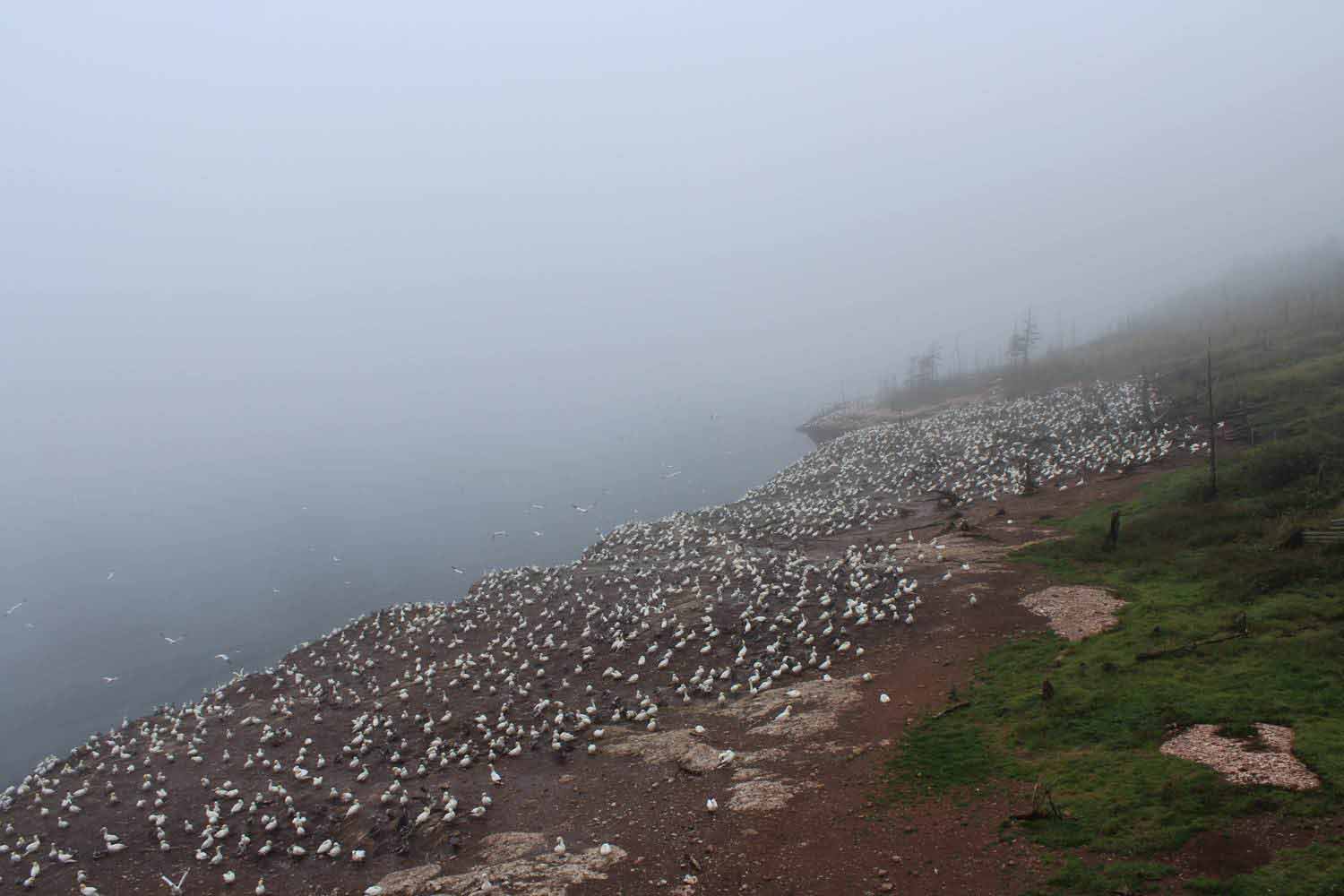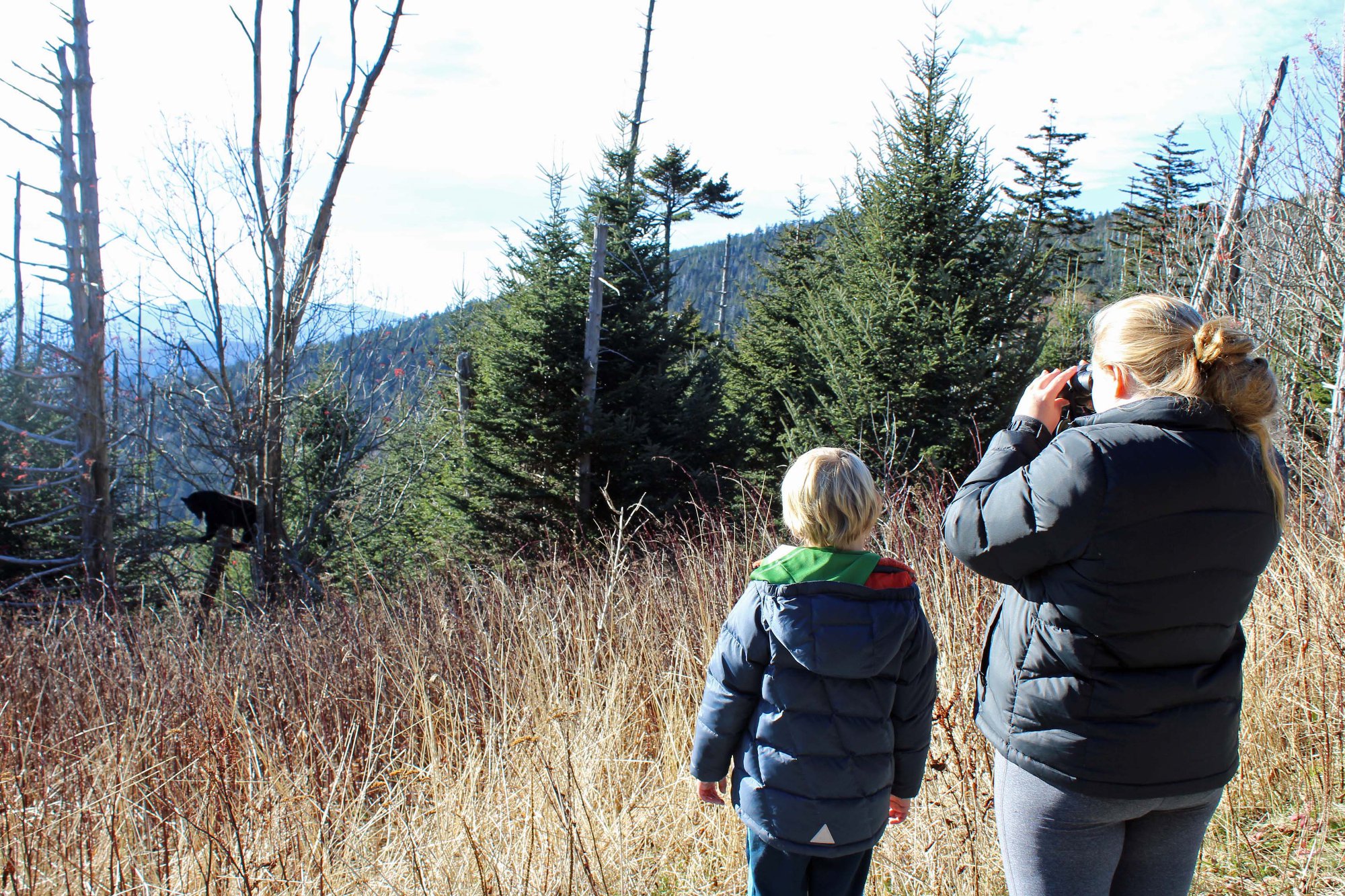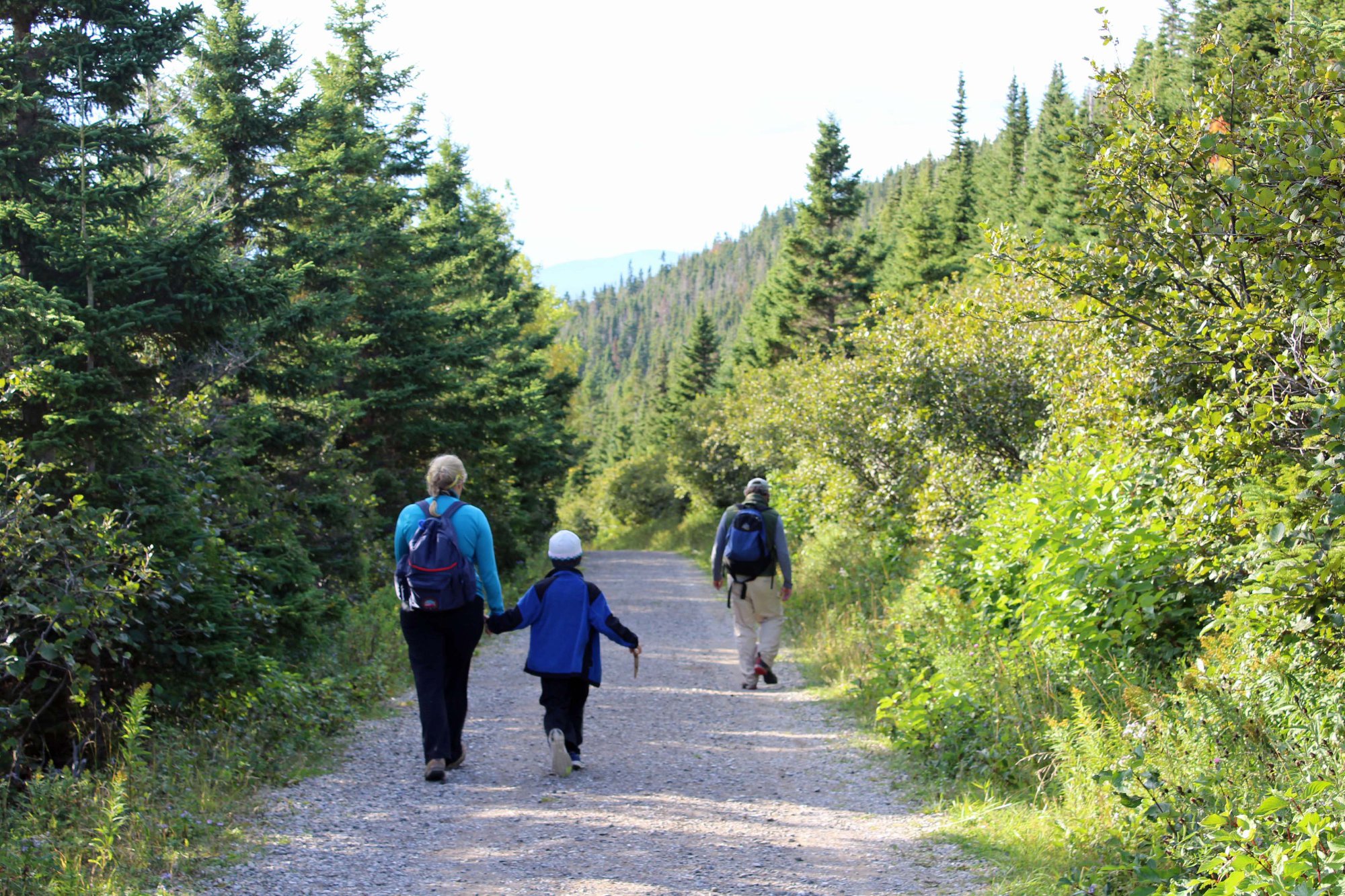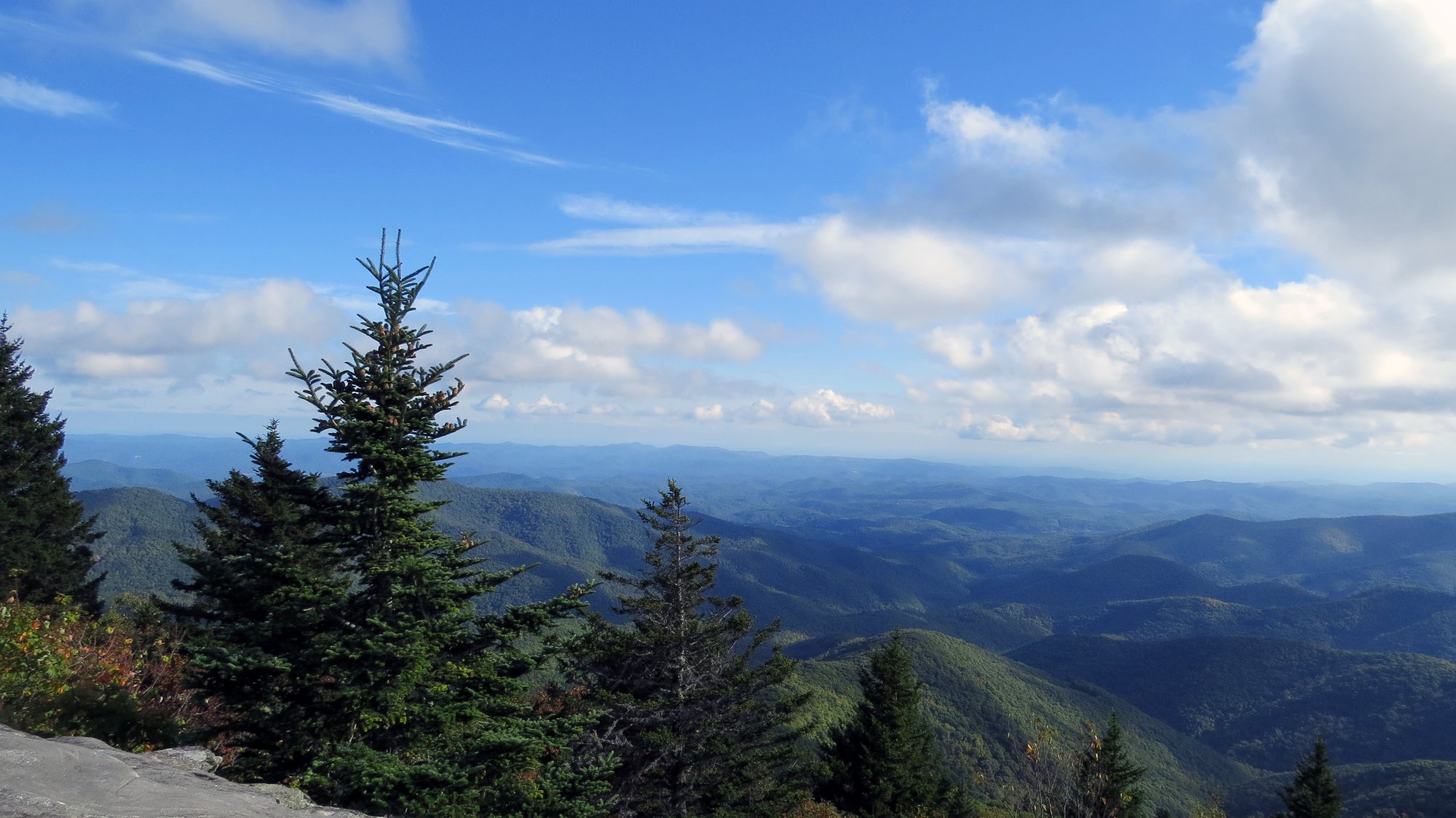Appalachian Odyssey
by Jim Melvin
A Clemson scientist and his family spend three months exploring the Appalachian Mountains — for the sake of conservation.
By defining the large, interconnected areas necessary to protect current and future biodiversity, Baldwin’s science can help local groups take action to hedge against these future uncertainties.
During his distinguished career as a conservation scientist, Rob Baldwin had hiked in the wilderness many times and savored the wonders of nature firsthand. But nothing he had ever experienced rivaled this.
On a flawless day in early fall, Baldwin stood motionless on the peak of a mountain in Quebec and reveled in the beauty of his surroundings. The sky—so perfect it lacked even the slightest wisp of cloud—arced around him like a deep blue dome. The crisp air felt enchantingly hushed, as if it too were in awe. A herd of antlered caribou surrounded him, heedless of his presence.
Baldwin knew that moments like these were rare and regretfully brief. If you overstayed your welcome, they lost their allure. So he left the mountaintop and slowly wound his way downward among a jumble of ancient boulders. Even then his wonder lingered, like dust on a well-worn jacket. When he finally reached his campsite, his family greeted him.
“Where’ve you been for so long?” his wife said. “The kids and I were worried.”
Baldwin had no answer, other than to smile.
A journey to remember
Baldwin, an associate professor of conservation biology and geographical information systems, has spent much of his career studying the fragmentation of wildlife habitats in North America. Because of this splintering—caused largely by human development such as cities, roads, and farms—many animals have lost their freedom to roam within and between their natural ranges. This disturbing lack of mobility and resulting inability to intermingle has had a devastating effect on a plethora of species. One of Baldwin’s more important avenues of research has been working with colleague Paul Leonard to redesign and enhance state-of-the-art habitat connectivity maps that can be paired with satellite imagery to display corridors that could be used by animal populations. These maps provide public and private decision makers with highly detailed information about what areas are more valuable than others when it comes to reestablishing and fortifying these essential passageways.
In a recently published research article, “Interacting Social and Environmental Predictors for the Spatial Distribution of Conservation Lands,” joint authors Baldwin and Leonard examine the existing distribution of conservation easements in the Appalachians. This ancient series of mountains, which extends from Alabama to northeastern Canada before plunging into the Atlantic Ocean and resurfacing in parts of Europe and Africa, has a long and complex history of human development and land use. Though relatively large swaths of the mountains and surrounding valleys are owned by the government and therefore publicly protected, the majority of the land is privately owned, especially in the lower elevations.
Because of this, conservation easements are extremely important. These legally binding restrictions, which are placed on pieces of private property to protect the lands for future generations, are either voluntarily donated or sold by landowners.
“Is the distribution of these easements driven by social factors, such as how people feel about the land?” Baldwin and Leonard ask. “Or is it driven by environmental factors? In our article, we concluded that it is more driven by social factors. We think people protect land that they know and love.”

On Isle de Bonaventure in Quebec, conservationists founded a project in the early twentieth century to protect these seabirds from egg predation.
Baldwin has been doing research on the article for years. And in September 2013, he and his family began a months-long sabbatical to test his theories in an experiential manner. Their objective? To travel virtually the entire length of the Appalachians, starting in Canada. Along the way, they would camp in a tent, explore as much of the land as time allowed, and meet with local conservationists.
“I just wanted to get on the ground,” Baldwin says. “I sit here in my office and map the stuff at 33,000 feet, and I wanted to get out there and see the people who are interested in these maps and talk to the decision makers who are using them.” Baldwin chose the Appalachians because he views them as the unifying element for conservation in the eastern United States.
“My wife Betty is also an associate professor at Clemson who focuses on the people side of conservation, so we organized our sabbaticals to start at the same time,” Baldwin says. “We had to spend the summer planning because we were going to camp every night. And we also had to do a lot of planning with our kids, because we were going to homeschool them along the way. There was a lot of prep work, to say the least. But finally, we jumped in the car and headed north.”
Cape Breton, Nova Scotia
On September 3, 2013, Rob, Betty, Ella and Julian (thirteen and seven at the time) arrived at Cape Breton, Nova Scotia, where they pitched their tent—affectionately called Big Agnes—on a high, cold plateau with wide-ranging views of the Atlantic Ocean. Cape Breton is home to a national park that stretches from one side of the island to the other.
“We camped in this spectacular high country,” Baldwin says. “And we could look out over the mountains right down to the ocean, where there were pods of pilot whales in the waves—and in the foreground, a moose. And we would hike down to the shore and just sit silently and watch.”
Most of the land in Nova Scotia is owned or leased by private timber companies, which feed their mills with the forests. The people who live there view these companies with a mixture of distrust and acceptance. Only about 12 percent of Nova Scotia is publicly owned and protected, but the province’s citizens have voted to require the government to increase that total to the global target of 17 percent. As you might imagine, the wheeling and dealing necessary to achieve such a goal can be complicated. While in Nova Scotia, Baldwin met with a pair of conservationists— David McKinnon and Peter Bush—who were using habitat corridor and biodiversity maps to prioritize which lands offered the maximum benefits.
“The overall purpose of the trip, for me, was to look at the theme of ‘How does conservation happen?’” Baldwin says. “And on my first stop, I encountered a classic example. Conservationists were working directly with private landowners, who in return would often provide valuable information. The landowners would say, ‘We haven’t cut that stand of trees for a hundred and fifty years. You should go look at that. We’re willing to do a deal, but we really want to keep this area over here because we’ve invested a lot in it.’ So they are making compromises in Nova Scotia that are really practical, while also satisfying the needs of the public who want more land for outdoor recreation.”
Gaspé Peninsula, Quebec
After spending about a week in Cape Breton, the family traveled across the environmentally fragile Chignecto Isthmus to the Gaspé Peninsula in eastern Quebec, where Baldwin had his transformative encounter with the caribou.
Like its sister province, Quebec also has an influential timber industry. But a much larger percentage of the land is publicly owned. Canadians, as a whole, adore the outdoors, and the colder it gets, the more they want to commune with nature. Cross-country skiers, including young children, will ski from hut to hut on the peaks of ragged mountains in eight feet of snow when it’s 20 degrees below zero.
“We saw one young couple biking three hundred miles around the peninsula in the rain and cold while towing their baby behind them,” Baldwin says. “And here we were driving.” He chuckled. “It made us feel really slack.”
Baldwin and his family set up camp in Forillon National Park, which is located at the outer tip of the peninsula. The managers of the spectacular park impressed Baldwin with their enthusiasm and diligence, but he found that not all was positive about this remote area of the world.
“Forillon is very isolated, and they do a really nice job there of education and conservation. There isn’t much private land activity going on up there. And this is true of Quebec, as a whole,” Baldwin says. “But there’s an enormous amount of provincial land, which is owned by the province and leased to timber companies. And there are very few people. The timber companies don’t do a beauty strip alongside the road. They just harvest for miles. There’s a lot of controversy about its effects on the environment. But some wildlife do benefit, particularly those that like early succession.”
While in Forillon, the family stood within a stone’s throw of black bears gorging on mountain ash berries. Two months later, they watched another population of bears eating the same type of berries in the Smoky Mountains.
“We were in Canada in early September watching bears eat the berries,” Baldwin says. “Scroll forward about two months, and we saw the same thing hundreds of miles south. It shows the ecological affinities at both ends of the Appalachians.”
Julian became fascinated with finding the colorful piles of mountain ash scat.
Parc National de la Gaspésie, Quebec
Their final stop in Canada was at Parc National de la Gaspésie, a provincial park that is near enough to Montreal and Quebec City to be a popular outdoor destination for those urban folk. The park has several core wilderness areas, but it also has more than its share of logging. Baldwin was relieved to find that the multiple uses were managed according to a regional conservation and recreation plan.
In the winter, snow falls so heavily that trail markers have to be placed atop ten-foot poles, but the harsh conditions don’t stop a small but viable population of woodland caribou from thriving there.
Throughout the Appalachians, we need to take the threat of rapid-onset climate change due to human-released carbon dioxide very seriously. The experience I had with the caribou may not be one my grandchildren can have.
“Up in Canada, the mountains are smaller than in the southern Appalachians, only about four thousand feet in the Chic-Chocs compared with six thousand and above in the Smoky Mountains near Clemson,” Baldwin says. “But in these relatively small mountains, you get tree lines. And that’s where the caribou are—above the tree line. This was another interesting parallel with the southern Apps, where elk have been reintroduced. At both ends of the spectrum, we have large mammals attempting to thrive. We have thousands of people enjoying the wilderness. We have multiple uses: timber harvest, trapping, recreation. To me, that’s a very hopeful scenario.
By defining the large, interconnected areas necessary to protect current and future biodiversity, Baldwin’s science can help local groups take action to hedge against these future uncertainties.
“Still, there is a sobering reality,” Baldwin continues. “Climate change will ultimately influence those high, fragile ecosystems first and most severely. Throughout the Appalachians, we need to take the threat of rapid-onset climate change due to human-released carbon dioxide very seriously. The experience I had with the caribou may not be one my grandchildren can have. Or, for that matter, finding fir and spruce on the tops of the Smoky Mountains.”
By defining the large, interconnected areas necessary to protect current and future biodiversity, Baldwin’s science can help local groups take action to hedge against these future uncertainties.
Surry, Maine
After several weeks of camping in the cold dampness of Canada, Baldwin and his family were pleased to return to the United States and sleep in real beds in his home state of Maine. Here, they gave Big Agnes a brief respite while they stayed with members of Baldwin’s family in Surry, a small town about 45 minutes south of the University of Maine.
During his stay in the state where he was raised and educated, Baldwin met with a pair of his longtime friends, Malcolm Hunter and Aram Calhoun, who are renowned conservation scientists.
Hunter and Calhoun provided another interesting example of public and private conservation collaboration. For most of their adult lives, they had worked to protect thousands of acres of privately owned land. Together, they helped broker deals with state government and private industry officials to strategically arrange a series of easements and public lands designed to reduce the land’s environmental vulnerability and enhance its habitat corridors.
“They’ve used their influence as well-known scientists to piece together this huge project that happens to be an area of high biodiversity,” Baldwin says. “So we went to their house and walked some of the land with them and talked about what motivated them to do this work. And Mac, who has been a professor at the University of Maine for about thirty years, said he started to work on it back in the ’80s because he loved the place. As he hiked there, he realized that few people knew or cared about these hills and wetlands in Down East Maine.”
Big changes in land ownership patterns began to occur in the late 1980s and continued through the 2000s, with big timber companies entering the real estate business by selling lucrative parcels of pristine wilderness land. In many areas of the United States, mansion-sized vacation homes were being built next to ponds and rivers and on the tops of ridges. An important habitat corridor connecting coastal and mountain forests was literally in Calhoun and Hunter’s backyard. But because of their diligence, the majority of the land is now protected.
“They managed some tricky political maneuvering, informed the state legislature, put out a lot of publicity, and, most importantly, got the major players together at the same table,” Baldwin says. “Some of the timber companies were interested because of sound management plans that were already in place. That’s what a lot of big timber companies are moving toward: ‘How can we make conservation part of our bottom line?’ They aren’t willing to do it on all their lands. But there are some places that they know are important ecologically and that they want to protect. And this gives them a viable reason to do this from a corporate point of view. In the United States, more than 80 percent of the land is in private hands. Conservation cannot progress without landowners who are engaged.”
Northern Vermont
After saying goodbye to his relatives, Baldwin and his family went to Vermont, a small but vibrant state with a spirited history of public engagement in conservation. In many ways, the area’s economy is linked to its natural beauty.
They stayed in several state parks and were pleased to see evidence of conservation everywhere. There was an extreme public consciousness and sensitivity about the land, with an extra emphasis on locally produced foods and other products.
“I was sitting in a coffee shop in Middlebury and a guy walked in with this giant mushroom called ‘chicken of the woods,’” Baldwin says. “And he sat there while I was drinking coffee and negotiated with the coffee shop owner, who ended up buying it on the spot for three hundred bucks. ‘Chicken of the woods’ mushrooms only grow in mature hardwood forests. And so it was interesting to learn that the people of Vermont were wild harvesting and making significant money.”
Baldwin visited with Nancy Patch, a county forester who works extensively with landowners in northern Vermont. Using habitat connectivity maps that Baldwin helped create, Patch has been, well, patching together a corridor between northern Vermont and Canada.
“When I make these maps, there’s a part of me that’s always thinking, ‘Does anyone really use them?’” Baldwin says. “So I was excited when Nancy called up a map on her computer screen, and it was one that I had worked on with a doctoral student, Ryan Perkl, at Clemson.”
Another Vermont conservation scientist named Sue Morse has been training landowners and volunteers to hike into the wilderness to identify and report animal tracks. This has resulted in a vast database of movement habits.
“So you have this army of people tracking lynx, bobcat, coyote, and bear. And everyone wants to be the one to find the wolf track,” Baldwin says. “And Sue connects them with the animals. She has the world’s largest traveling collection of pelts from mountain lions, wolves, and grizzlies. And she has skulls and skeletons that she lets the kids look at and pick up. To me, that’s where a love for conservation begins, when you can get someone to actually care.”
The Adirondacks
After their stay in Vermont, the Baldwins left the Appalachians for the first time and headed across Lake Champlain to the Adirondacks, a ring of remote mountains in northern New York. There they spent five days exploring vast blocks of the largest wilderness area in the eastern United States.
“We saw extreme, shocking poverty in those mountains,” Baldwin says. “You’ll have one really affluent town like Lake Placid. And then twenty miles away you’ll have a town where literally only one out of every ten storefronts is open. This is a huge, thinly populated area. They’re talking about wolves showing up in the Adirondacks from Canada, and there is a lot of other wildlife, as well.”

While in Forillon, the family stood within a stone’s throw of black bears gorging on mountain ash berries. Two months later, they watched another population of bears eating the same type of berries in the Smoky Mountains.
Western Massachusetts
The family left the deep wilderness behind and traveled to western Massachusetts, which, like Vermont, is also intensely committed to local conservation. The state contains thousands of easements that have been cleverly arranged to protect habitats over large areas. And more importantly, most of the easements are well managed.
“A problem with easements is making sure they are monitored and protected. And this takes money,” Baldwin says. “So people in Massachusetts had some great ideas about how to generate this money. For instance, they’re putting small sawmills on the easements that are selectively harvesting high-value trees. Then they are selling them as local lumber and using those funds to support the management of the easements.”
The family spent a week in western Massachusetts and was impressed by how passionate its residents were about preserving the state’s natural splendor. Baldwin described the area as “ground zero” for conservation planning.
“For many years, they have had programs to help salamanders cross roads when they’re migrating in the spring,” Baldwin says. “The local citizens go out in the middle of the night in a rainstorm and fill buckets with frogs and salamanders on one side of the road and move them to the other side. When I talk to my students about this here at Clemson, it always seems to blow them away. Education filters into the community—and then people think, ‘Oh, this is something we should do.’”
Hawk Mountain
The family next drove to Hawk Mountain Sanctuary, an international center for raptor conservation, observation, and research located along the Appalachian flyway in eastern Pennsylvania. The sanctuary has been a hawk-migration monitoring site since the 1930s.
“Hawk Mountain is an example of interpretation that reminds us why conservation is important to us as humans,” Betty Baldwin says. “They use art and information to help visitors of all ages explore why the mountain serves as a funnel for raptors on the eastern edge of North America—and also where it fits into conservation on a global scale.”
The Blue Ridge Parkway
The family then drove down through Virginia along the Blue Ridge Parkway in the southern Appalachians. Baldwin met with several colleagues during this part of the trip, including Jeff Walters, an ecology and conservation biologist at Virginia Tech.
“Jeff has worked with endangered species management a lot, and he believes that scientists need to provide relevant information and let the policy makers make the decisions,” Baldwin says. “This is not something I entirely agree with. I think we need to be a little bit more involved. We need to provide sound information and, when necessary, advocate for the use of that information. You can’t just hand them a piece of paper.”
The Smoky Mountains
It was now late November, and the long journey was nearing its end. The family was weary but also brimming with wonderful memories. But one final stop remained—the Smoky Mountains, where Rob had proposed to Betty twenty-five years ago. So being there with their kids made the visit extra special.
They stayed a week at Cade’s Cove, a verdant valley that is one of the Smokies’ most popular destinations.
“We did a bunch of hikes,” Baldwin says. “And then we spent a couple of days at Oconaluftee Valley observing the elk. These huge animals are surprisingly approachable. But this also causes problems. Some tourists are too bold and are getting injured.”
Chattanooga
After leaving the Smokies, Betty, Julian, and Ella returned to their home in Clemson. But Baldwin wanted to make one final trip on his own. So he went to the University of Tennessee at Chattanooga to meet with Andy Carroll, the GIS manager for the Center of Academic and Innovative Technologies.
“Andy and I drove down Lookout Mountain, which looms over the valley of the Tennessee River where there had been battles during the Civil War,” Baldwin says. “And Andy described how conservationists around Chattanooga are achieving complementary goals by protecting historical sites that also serve as habitat corridors. This reinforced the main thing I learned from the sabbatical: The more reasons you have to conserve a place, the more likely it’s going to happen. People are connected to the lands. Emotions can get them to take out their checkbooks.”
Baldwin is writing a book about his research. The mountains he learned to know and love so well will play a major role in his story.
“My family and I—and Betty and I, as professionals—brought back to Clemson an experiential perspective on people and the land,” Baldwin concludes. “And it continues to influence how we teach and communicate research. It’s naïve for academics to think our research will do much in the world unless we are willing to reach out to the people and places we are writing about. Betty takes busloads of students around the region. I spend a lot of time explaining conservation science to local conservationists from here to Maine.”







